| |
(The case for increasing rates of certain kinds of skin cancer as a result of prolonged exposure to UV-B 280-320 nm radiation.)
In order to fully understand the origins, cure(s), and prevention of solar radiation-induced skin cancers, it is necessary to employ aspects of virtually all of the disciplines listed in the introduction. Hence, Medical Ecology offers the most comprehensive approach to the study of this life-threatening disease. What follows is a detailed description of its epidemiology, medical geography, molecular biology and medical and environmentally based intervention strategies. Depletion of the ozone layer  and its predicted consequences for increasing the prevalence and incidence of skin cancers will be presented, as well. and its predicted consequences for increasing the prevalence and incidence of skin cancers will be presented, as well.
Skin cancers of all kinds are on the rise, worldwide. There is no debate over this fact, no matter which group of epidemiologists are consulted, but why is it increasing? Is it because there are just more of us? The rate per thousand people is increasing, so simply attributing the rise to an increase in the total number of cases isn't enough to answer the question. Perhaps we are spending more time in the sun. This simple statement is probably correct, but knowing that does not supply us with the mechanism(s) which cause it. Recent advances in the genetics of cancer strongly suggest that pre-dispositions to many kinds of cancer are correlated with mutated forms of oncogenes, some of which can be mutated by environmental exposures. One or more of these mutated genes are thought to be the main players in the induction of skin cancer. How might oncogenes and the environment interact? Specifically, how does an increased exposure of unprotected skin to sunlight result in cancer of the basal cells of the epidermis?
First, we need to know what happens when epithelial cells are exposed to solar radiation of wavelengths 280-320 nm.
Electromagnetic Spectrum of Energy |
 |
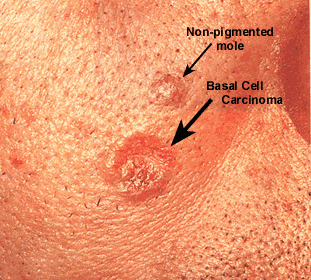 |
|
Basal Cell Carcinoma (BCC),
most likely induced by solar radiation.
(From Reeves & Maibach, Clinical Dermatology Illustrated) |
This is the most energetic part of the spectrum of solar radiation that passes through stratospheric ozone layer  and reaches the earth's surface. The remainder of potentially harmful radiation is filtered out by the ozone layer. The 280-320 nm band of energy also has been shown to induce DNA damage resulting in skin cancers in experimental animals and reaches the earth's surface. The remainder of potentially harmful radiation is filtered out by the ozone layer. The 280-320 nm band of energy also has been shown to induce DNA damage resulting in skin cancers in experimental animals  . We know from world distributions of skin cancer rates and related epidemiological surveys, that people from the northern regions of Europe and the British Isles are among the most susceptible in the world to skin cancers when they are exposed to UV-B 280-320 nm. In their native countries, however, skin cancer rates are low. It is only when they migrate to regions closer to the equator that their skin cancer rates increase. Immigrating to Australia from Scotland and England, as many did, allows for such a situation to develop, as it surely did. Many Europeans were "put" there by rigid English law during the turn of the 18th and early 19th century. Irish, too, suffered the fate of transportation, winding up on “The Fatal Shore” of that island continent (title of a book on that fascinating period of history by Robert Hughes). Most of these new settlers of Australia suffered the growing pains of integrating to the ecology of a new continent; starvation , lack of sufficient drinking water, and inadequate shelter were the main causes for human suffering in those days. Today, their descendants suffer from a new set of afflictions, partially due to their affluence, in which an increase in leisure time has led to activities related to sun worship; surfing, nude sun bathing, boating, swimming and just lying around on the numerous beautiful beaches that characterize the eastern shore of that country. The situation is somewhat different in Denver, the "mile high" city, where a thin atmosphere cannot effectively prevent the penetration of most of the spectrum of ultraviolet radiation. Exposure to sunlight in that city is less than that on any given day on Bondi beach in Sydney, yet the outcome is the same. Other high altitude populations in the United States also show an increased rate of skin cancer, adding credence to the hypothesis that in those settings, skin cancer is directly correlated to an increase in exposure to UV-B 280-320 nm. . We know from world distributions of skin cancer rates and related epidemiological surveys, that people from the northern regions of Europe and the British Isles are among the most susceptible in the world to skin cancers when they are exposed to UV-B 280-320 nm. In their native countries, however, skin cancer rates are low. It is only when they migrate to regions closer to the equator that their skin cancer rates increase. Immigrating to Australia from Scotland and England, as many did, allows for such a situation to develop, as it surely did. Many Europeans were "put" there by rigid English law during the turn of the 18th and early 19th century. Irish, too, suffered the fate of transportation, winding up on “The Fatal Shore” of that island continent (title of a book on that fascinating period of history by Robert Hughes). Most of these new settlers of Australia suffered the growing pains of integrating to the ecology of a new continent; starvation , lack of sufficient drinking water, and inadequate shelter were the main causes for human suffering in those days. Today, their descendants suffer from a new set of afflictions, partially due to their affluence, in which an increase in leisure time has led to activities related to sun worship; surfing, nude sun bathing, boating, swimming and just lying around on the numerous beautiful beaches that characterize the eastern shore of that country. The situation is somewhat different in Denver, the "mile high" city, where a thin atmosphere cannot effectively prevent the penetration of most of the spectrum of ultraviolet radiation. Exposure to sunlight in that city is less than that on any given day on Bondi beach in Sydney, yet the outcome is the same. Other high altitude populations in the United States also show an increased rate of skin cancer, adding credence to the hypothesis that in those settings, skin cancer is directly correlated to an increase in exposure to UV-B 280-320 nm.
If this is true, then what is the precise connection between increased exposure to UV-B 280-320 nm and activation of oncogenes? To answer this question, we first need to know something about the ways in which DNA is synthesized and how it is repaired in the presence and absence of mutagens. It is known from many in vivo and in vitro experiments that UV-B 280-320 nm causes the condensation of ethylene groups to form cyclobutane pyrimidine dimers.
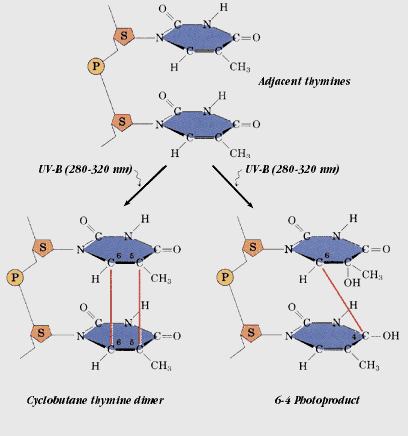 |
This reaction classically occurs between two adjacent thymine residues on the same strand of DNA. These damaged sections of DNA are usually repaired during the next cycle of DNA synthesis by a variety of unrelated enzymes (e.g. 6-4 photolyase-like enzymes; nucleotide-excision repair enzymes; base-excision repair enzymes). Should any of these DNA repair mechanisms fail during DNA synthesis, the DNA polymerase enzyme can "skip" over the linked pair causing a reading error in that coding region. When gene expression occurs, the altered triplet code for that particular amino acid is transcribed instead of the normal version, resulting in a mutant protein, often with new biological activity related to increases in the rate of cell division. Although the gene(s) responsible for solar radiation-induced skin cancers has yet to be cloned and its cDNAs sequenced, it is likely that this is the mechanism by which these cancers arise.
If UV-B 280-320 nm skin cancers are caused by increased exposure to unfiltered sunlight, then several intervention strategies should be employed that could reverse this worldwide trend. To begin with, it has been recommended by the American Cancer Society and The National Cancer Institute that patients with family histories of high rates of skin cancer should avoid direct exposure to sunlight whenever possible. This behavior change is particularly hard to incorporate into our lives, since we all are attracted to the outdoors, especially as children. Advertisements from the hotel and airline industries tempt us to visit places where the sun shines all day long and lounge on the beach.
It is thought that the process of skin cancer begins with a primary exposure, then upon re-exposure at a much later date, the actual basal cell carcinoma arises. Often the cancer is in an anatomic location quite removed from our preconceived notion of where skin cancers manifest themselves. The top surface of the foot and ankle appear to be the most common sites for skin cancers related to sunlight exposures. Running around without shoes all day long as children might well turn out to be the initial event that later on leads to the cancer. Sun blocking agents of all kinds have long been touted as a means of preventing skin cancers. However, the amount and frequency with which topical lotions must be applied limits their effectiveness to only those individuals that carefully read the labels and apply them accordingly when active in the outdoors. The wearing of large hats, and covering most surfaces of our bodies with clothing designed to keep out the sun seems to go against the prevailing sense in western society that maintains that a good, dark tan is the look of health and well-being, yet this strategy offers the best chance of allowing us to live a skin cancer-free life. Fortunately, skin cancers induced by solar radiation has a high rate of cure by surgery, and because of this the mortality rates are low in most parts of the world.
A confounding factor on the environmental side of the equation of contributing factors leading to skin cancers is the role that holes in the stratospheric ozone layer play in this skin disease. Depletion of the ozone layer in the Spring (i.e., October) in the extreme southern hemisphere has been occurring for some time now. It has also begun to show up each Spring over the north pole, as well. The hole in the ozone layer is created by the accumulation of chlorine containing compounds in the upper atmosphere, largely in the form of chlorofluorocarbons (CFCs for short). These compounds originate on the ground and are the active ingredients of refrigerants, coolants, and spray can aerosolizers, to name a few. The chlorine in them is the active ingredient in ozone depletion. Photo reactive products of CFCs, created in the stratosphere when the sun shines for the first time in the Spring is the chemical mileau in which ozone depletion occurs. Interacting with 03 is a chemical property shared by all the halides, but chlorine and fluorine do it best. Bromine is next in line, followed by iodine and lastly by astatine. Even small amounts of chlorine or bromine can deplete vast amounts of ozone due to chemical recycling reactions. Thus, the amount of Photo reactive products created in the upper atmosphere determines how large the hole will be that year and, most important, how long it will take to repair it. Each year since we have been keeping records, the hole over Antarctica has gotten larger and taken longer to heal over. An international treaty has been agreed upon by most of those nations that produce CFCs. It was signed in Montreal, Canada, in 1987, and implemented immediately thereafter. Of all the major countries involved in CFC production, only China refused to sign on. But even if all nations were to stop using CFCs, it would be another 50 or so years before the ozone layer would no longer suffer annually.
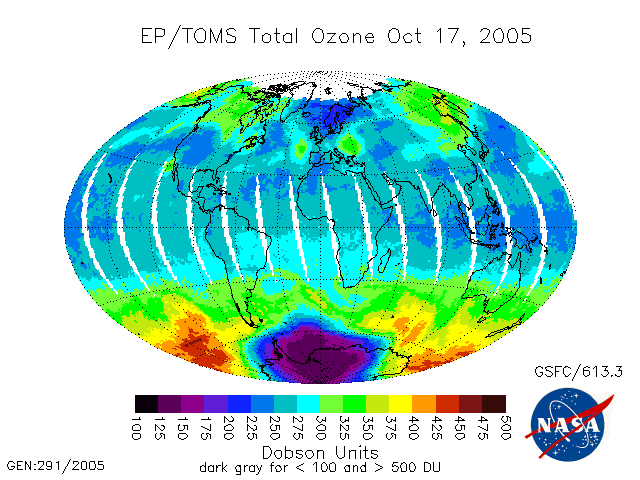
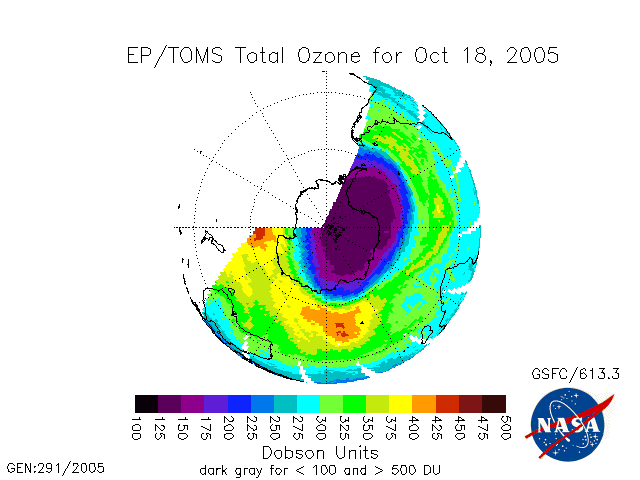
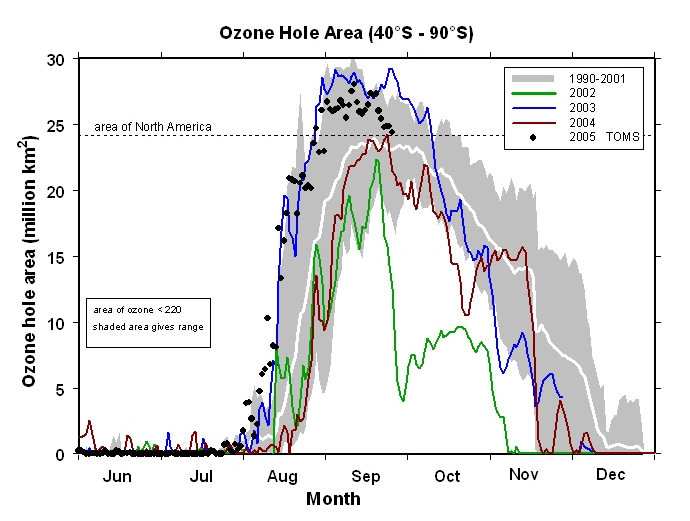

Do these ozone holes have repercussions for those of us that live in temperate zones ? It is too soon to give a definitive answer to this question, but we know that in the southern ocean, increases in UV-B 280-320 nm radiation has an adverse effect on other life forms vital to the maintenance of some of the world's most highly productive ecosystems. Most species of phytoplankton in the Southern Ocean are extremely sensitive to UV-B radiation and are killed when levels exceed their tolerance limits even by small amounts.
Phytoplankton are the sole basis for the food chains and food webs of that ocean, with krill and zooplankton being their main consumer groups. Krill, (small shrimp-like creatures) are the keystone species that are the main food source for many species of penguins, most filter-feeding whale species, including the largest animal to ever live (i.e. the great blue whale), and many species of fish. Without krill, the Southern Ocean's ecosystems would surely collapse. What this means for the rest of the world's terrestrial plants and animals is unknown, but it would most likely have profound effects, nonetheless. That we cannot yet predict those consequences reflects more on our lack of fundamental knowledge regarding global effects of ocean ecosystem disturbance, and less on our knowledge of the resiliency of those aquatic ecosystems. Perhaps by employing all the disciplines embraced by Medical Ecology to the "ozone problem", we can reach an even greater balance with the life forms that provide, as yet unidentified ecosystem services that make our lives more bearable and disease-free.
Recent evidence supports the view that increased levels of UV-B radiation due primarily to stratospheric ozone depletion are harmful to terrestrial ecosystems, as well. Higher plants appear to show damage effects that make them either more, or in some cases, less susceptible to insects that feed on damaged tissues. In addition, assemblages of soil microbes, particularly those responsible for nitrogen fixation (e.g., spirochetes and root nodule organisms) are severely affected . If the hole in the ozone layer continues to widen both in the southern and northern hemispheres, then the chances that the grasslands of the Arctic tundra and Tierro del Fuego may well become adversely affected. Loss of primary productivity in the tundra, for instance, could result in dramatic changes in the seasonally regulated population dynamics of voles, snowy owls, lynx, caribou and wolves. These changes, could in turn, affect human populations that depend upon some of these animals for food. In addition, insect populations (e.g., mosquitoes and blackflies) could also become affected, with unpredictable ecological consequences.
[Back To Top] |
|